To preserve your herbal bounty, focus on smart harvesting and drying techniques. Pick your herbs just before they bloom, ideally in the early morning, to capture maximum flavor. Dry them by air, oven, or dehydrator, ensuring they're in a ventilated area at the right temperature. Store dried herbs in airtight containers away from moisture and light to maintain quality. Experiment with flower-based teas like chamomile and hibiscus, balancing flavors for perfect blends. Pair your creations with inviting aromas and enjoy the health benefits they offer. You'll discover even more tips to enhance your herbal tea experience.
Importance of Drying Herbs
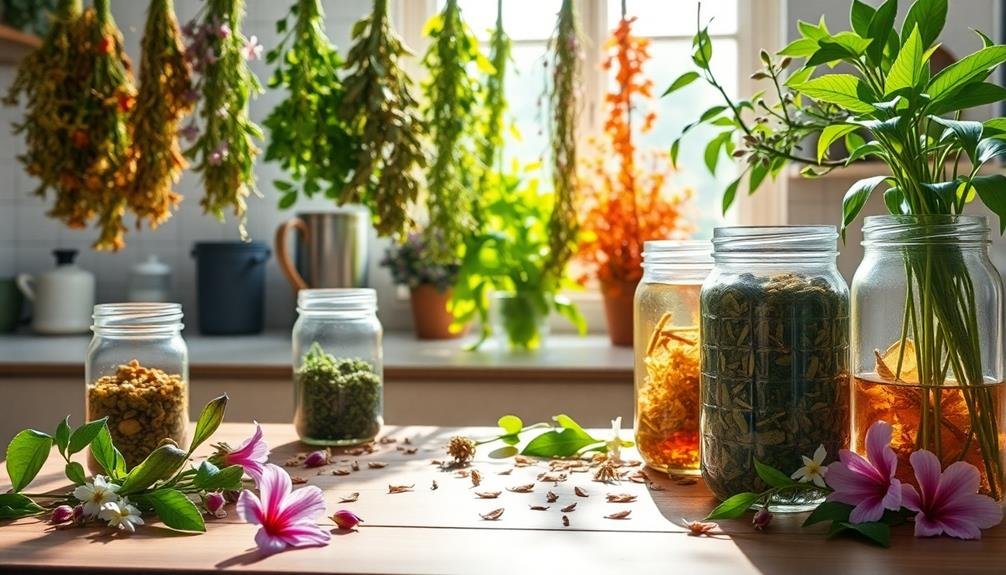
Why is drying herbs so vital for your herbal tea blends? When you dry herbs, you're preserving their flavor, aroma, and health benefits. Fresh herbs contain moisture, which can lead to spoilage and mold if not used promptly. By removing that moisture, you're extending the shelf life of your herbs, allowing you to enjoy your favorite blends long after the harvest.
Moreover, drying concentrates the flavors of your herbs. You'll notice that dried herbs often have a more robust taste than their fresh counterparts. This intensity is essential for creating rich and satisfying tea blends. It also allows you to experiment with proportions, as dried herbs are more potent than fresh ones.
Additionally, the drying process locks in essential oils, which carry the unique properties of each herb. These oils contribute to the therapeutic benefits of your tea, making your blends not only delicious but also beneficial to your health.
Best Flowers for Tea
When crafting herbal tea blends, incorporating flowers can elevate your brews with unique flavors and aromas. Some of the best flowers for tea include chamomile, hibiscus, and lavender.
Chamomile, with its sweet, apple-like flavor, promotes relaxation and soothes the stomach. It's perfect for winding down after a long day.
Hibiscus, on the other hand, offers a tart, cranberry-like flavor that's both invigorating and vibrant. Rich in antioxidants, it's excellent hot or iced, making it versatile for any season.
If you're looking for a fragrant addition, lavender's soothing floral notes can enhance your blend, creating a calming experience that's great for stress relief.
Other notable flowers include rose petals, which lend a delicate sweetness and floral aroma, and elderflower, known for its subtle honey-like taste.
You might also consider adding calendula, which adds a mild, earthy flavor while contributing a beautiful golden hue to your tea.
Experimenting with these flowers can transform your herbal blends, providing not just flavor but also health benefits.
Harvesting Techniques
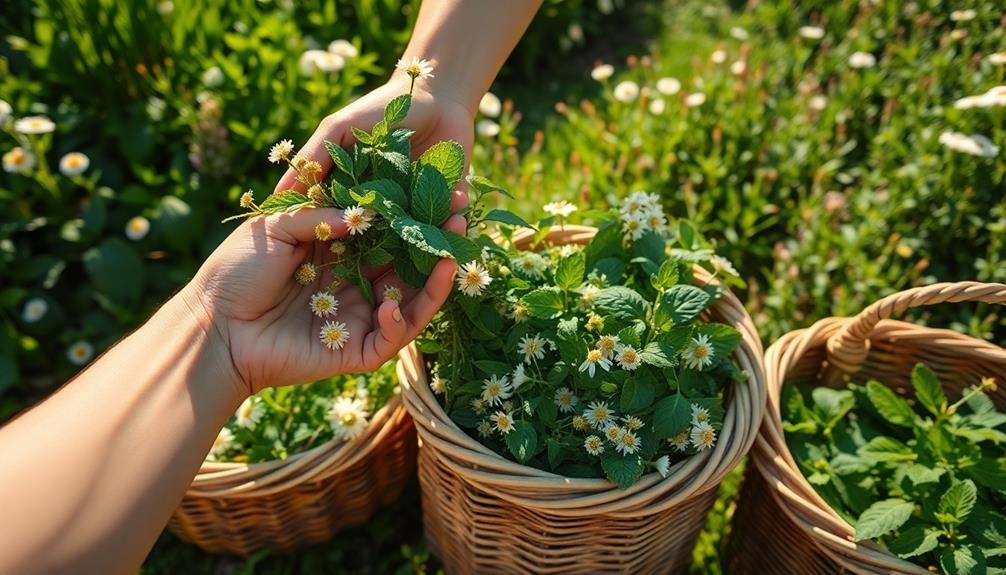
When you're ready to harvest your herbs for tea, timing is essential for the best flavor.
You'll want to use proper cutting methods to guarantee the plants thrive and keep their potency.
After harvesting, mastering drying and storage techniques will help preserve the quality of your herbal tea blends.
Optimal Harvest Timing
How can you guarantee the best flavor and potency in your herbal tea blends? Timing your harvest is essential. The best time to harvest herbs is just before they bloom, as this is when they're richest in oils and flavor compounds. Early morning is ideal, as the dew has dried but the plants are still cool, preserving their essential oils.
Here's a quick reference to ideal harvest times for popular herbs:
| Herb | Best Harvest Time | Notes |
|---|---|---|
| Mint | Late morning | After the dew dries |
| Chamomile | Early afternoon | When flowers are open |
| Lemon Balm | Morning or evening | Before blooming |
Proper Cutting Methods
After timing your harvest perfectly, using the right cutting methods is essential for preserving the quality of your herbs. Start by using sharp, clean shears or scissors to make precise cuts. This minimizes damage to the plant and helps prevent disease. Aim to cut just above a node or leaf joint, which encourages new growth and guarantees your plant continues to thrive.
When harvesting, be mindful of the quantity. It's best to take no more than one-third of the plant at a time. This approach allows the herb to recover quickly and produce more leaves for future harvests.
If you're working with woody herbs, like rosemary or thyme, use a gentle sawing motion to avoid crushing the stems.
Always cut in the morning after the dew has dried, as this is when the oils in the herbs are most concentrated. Avoid cutting during rainy or excessively humid days, as moisture can lead to mold or mildew.
Drying and Storage Techniques
Properly drying and storing your herbs is essential for preserving their flavor and potency, especially when creating herbal tea blends. To achieve the best results, you'll want to follow a few straightforward techniques.
Start by harvesting your herbs on a dry day, preferably in the morning after the dew has evaporated.
You can use several methods for drying, such as:
- Air drying: Bundle stems together and hang them upside down in a dark, well-ventilated area.
- Oven drying: Place herbs on a baking sheet at a low temperature (around 180°F) for a few hours, checking frequently.
- Dehydrator: Use a food dehydrator for a quick and efficient drying process.
Once your herbs are thoroughly dried, store them in airtight containers, away from light and moisture. Glass jars work well, but make sure they're labeled with the herb name and date.
Remember to check your stored herbs periodically, discarding any that show signs of mold or spoilage.
With these techniques, you'll guarantee your herbal tea blends maintain their delightful flavors and health benefits for months to come!
Methods for Drying Flowers
When it comes to preserving the beauty and flavor of your harvested flowers, you've got several effective drying methods at your disposal.
You can choose from air drying, using an oven, or even a dehydrator, depending on your needs and available resources.
Let's explore these techniques so you can enjoy your floral treasures in your herbal tea blends.
Air Drying Techniques
Air drying flowers is a simple yet effective way to preserve their vibrant colors and delicate fragrances for your herbal tea blends. This method requires no special equipment, making it accessible for everyone.
To get started, choose healthy, pesticide-free flowers, and make sure to harvest them at their peak bloom.
Here's how to successfully air dry your flowers:
- Bundle Wisely: Gather small bunches of flowers and tie them with twine or rubber bands. Avoid overpacking the bundles, as good airflow is essential for even drying.
- Choose the Right Location: Hang the bundles upside down in a cool, dark, and well-ventilated area. This helps maintain the flowers' colors and prevents mold growth.
- Be Patient: Depending on the type of flowers, drying can take anywhere from a few days to a couple of weeks. Check regularly for dryness, and when they feel crisp, they're ready to use.
Oven Drying Method
For those short on time, the oven drying method is a quick and efficient way to preserve flowers for your herbal tea blends.
Start by preheating your oven to the lowest setting, ideally around 150°F (65°C). While the oven warms up, gather your fresh flowers and gently rinse them to remove any dirt or insects. Pat them dry with a clean towel to avoid moisture.
Next, arrange the flowers in a single layer on a baking sheet lined with parchment paper. Make sure they aren't overlapping, as this can lead to uneven drying.
Place the baking sheet in the oven, leaving the door slightly ajar to allow moisture to escape. Check the flowers every 15 to 20 minutes, turning them if necessary. Depending on the type of flowers and your oven's temperature, they may take anywhere from 30 minutes to an hour to fully dry.
Once the flowers are crisp and crumble easily, remove them from the oven and let them cool.
Store your dried flowers in an airtight container, away from light and moisture. Now, you're all set to create vibrant herbal tea blends!
Dehydrator Usage Tips
If you're looking for an alternative to the oven drying method, using a dehydrator can be a fantastic option for preserving flowers. Dehydrators offer controlled heat and airflow, ensuring that your blooms dry evenly without losing their vibrant colors or delicate shapes.
Here are some tips to get the most out of your dehydrator:
- Select the Right Flowers: Choose flowers that are known for their drying properties, like lavender, chamomile, or hibiscus. Avoid those with high moisture content, as they may not dry well.
- Prep Your Flowers: Remove any excess leaves and cut stems to a manageable length. Smaller pieces tend to dry more evenly and quickly.
- Set the Correct Temperature: Most flowers do well at a temperature of around 95°F to 115°F. Monitor the drying process regularly to avoid over-drying, which can lead to brittle petals.
Once dried, store your flowers in airtight containers, away from light and moisture.
This method not only preserves their beauty, but it also allows you to create delightful herbal tea blends, bursting with flavor and aroma. Happy dehydrating!
Ideal Drying Conditions
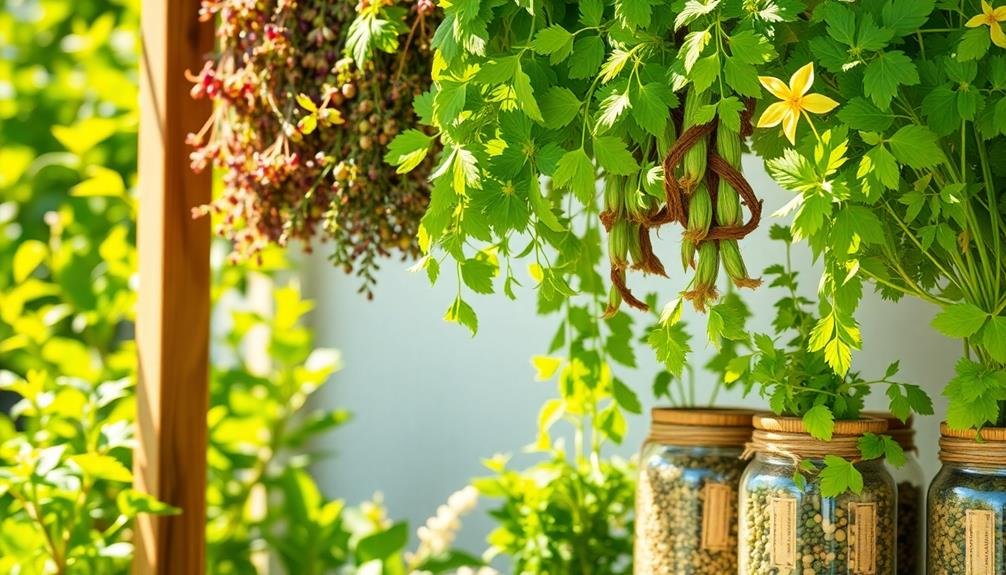
Creating the perfect environment for drying herbal tea blends is essential to preserving their flavor and medicinal properties. First, you'll want to choose a location with good air circulation. A well-ventilated room helps prevent moisture buildup, which can lead to mold. Aim for a temperature between 80°F and 100°F (27°C to 38°C) for ideal drying.
Next, consider the humidity level. Ideally, you should keep it low—around 30% to 50%—to guarantee your herbs dry quickly and effectively. High humidity can interfere with the drying process, leaving your herbs damp and prone to spoilage.
When laying out your herbs, spread them in a single layer on a drying rack or screen. This allows for even airflow, guaranteeing all parts of the herbs dry uniformly.
If you're using a dehydrator, remember to set it to a low temperature to avoid cooking the herbs, which can diminish their potency.
Storing Dried Herbs
After drying your herbs, proper storage is essential to maintaining their flavor and potency.
You'll want to choose the right containers and conditions to guarantee your herbs stay fresh for as long as possible. Ideally, you should store your dried herbs in airtight containers made of glass, metal, or dark plastic to shield them from light and moisture.
Here are a few key tips to keep in mind:
- Cool, Dark Place: Store your containers in a cool, dark cupboard or pantry. Heat and light can degrade the quality of your herbs over time.
- Avoid Humidity: Make sure the containers are completely dry before adding your herbs. Humidity can lead to mold growth and spoilage.
- Label and Date: Always label your containers with the herb name and the date you dried them. This helps you keep track of freshness and usage.
Creating Your Tea Blends

Creating your own herbal tea blends is all about choosing fresh ingredients that excite your palate.
You'll want to balance flavors and aromas to create a harmonious cup, so don't hesitate to experiment with different ratios.
The more you play around, the closer you'll get to your perfect brew.
Choosing Fresh Ingredients
Fresh ingredients are the heart of any great herbal tea blend. When you choose high-quality, fresh herbs, you elevate the flavor and health benefits of your tea. To guarantee you're selecting the best ingredients, consider these key factors:
- Harvest Time: Always pick herbs at their peak. This guarantees maximum flavor and potency.
- Storage Conditions: Store your herbs in a cool, dark place. This helps retain their freshness and aroma.
- Organic Options: If possible, opt for organic herbs. They're free from pesticides and chemicals, making for a healthier brew.
When you prepare your tea blends, focus on the color and aroma of the herbs. Vibrant colors and strong scents are indicators of freshness.
If you're using dried herbs, check their expiration dates and avoid anything that looks dull or faded. Fresh ingredients not only taste better but also provide more nutrients.
Balancing Flavors and Aromas
Balancing flavors and aromas in your herbal tea blends is essential for crafting a satisfying experience. Start by identifying the dominant flavors you want in your blend—think of herbs, flowers, and spices. For instance, if you choose chamomile, its sweet, apple-like flavor can be complemented by the invigorating notes of mint or the floral essence of lavender.
Next, consider the aromas. A well-rounded blend should have a pleasing scent that enhances the drinking experience. If you're using bold ingredients like ginger, balance it with lighter herbs like lemon balm to soften the overall profile.
Don't forget about the texture and mouthfeel; some herbs may provide a smooth finish while others could add a bit of earthiness. Aim for harmony in your blend, where no single flavor or aroma overpowers the others.
Always keep in mind that your personal preferences play an essential role. Taste as you mix, adjusting the proportions until you create a blend that resonates with your palate.
Experiment, trust your instincts, and enjoy the delightful journey of creating your perfect herbal tea blend!
Experimenting With Ratios
When you immerse yourself in experimenting with ratios for your herbal tea blends, you'll discover how different proportions can drastically change the flavor profile. Each herb brings its unique taste and aroma, and adjusting the ratios can enhance or mute certain characteristics.
You might find that a little extra peppermint can add an invigorating kick, while a pinch of chamomile can soften the blend's intensity.
To get started, consider these key points:
- Balance: Aim for a mix that highlights your favorite flavors without overwhelming them.
- Taste Testing: Don't hesitate to brew small samples. Adjusting one herb at a time helps you understand its impact.
- Record Keeping: Keep notes on your experiments. This way, you can replicate successful blends or tweak them further.
Flavor Pairing Tips
Experimenting with flavor pairings can often lead to delightful surprises in your herbal tea blends. Start by considering the base of your tea. If you're using chamomile, its sweet, floral notes pair beautifully with hints of citrus from lemon balm or orange peel.
For a spicier profile, try adding ginger to peppermint for an invigorating kick.
Think about complementary flavors. Consider pairing earthy herbs like rooibos with sweet elements like vanilla or caramel for a comforting blend.
If you're feeling adventurous, mix floral herbs like hibiscus with the boldness of black tea for a vibrant, tangy experience.
Don't forget about balancing flavors. If you've got a strong herb, like sage, balance it with something milder, like green tea or a hint of honey for sweetness.
Use fresh herbs when possible, as they can add a lively dimension to your blends.
Keep a journal of your pairings. Note what works and what doesn't; this will help you refine your blends over time.
Health Benefits of Herbal Teas
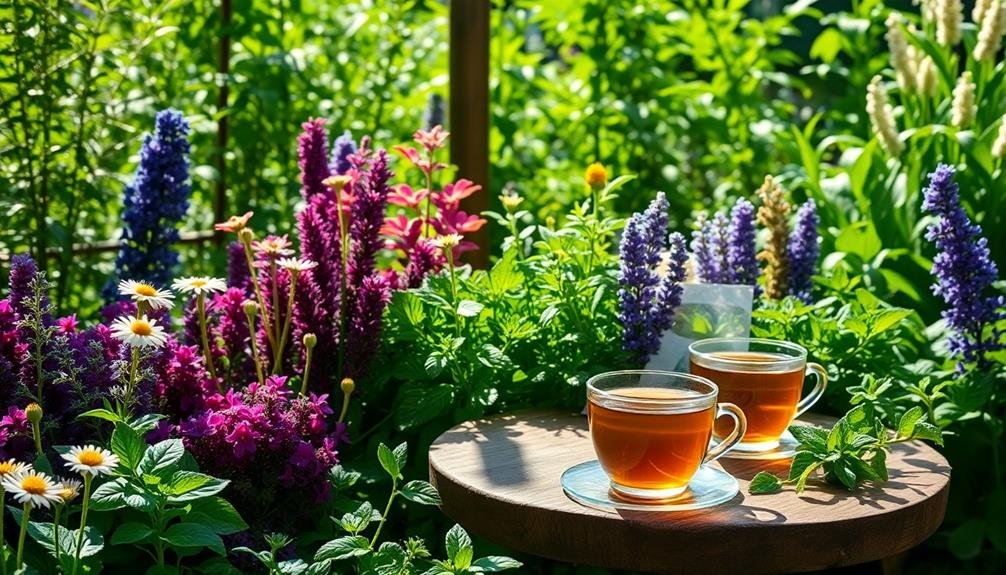
Herbal teas offer a wealth of health benefits that can enhance your well-being. When you sip on these fragrant brews, you're not just enjoying a delicious drink; you're also nourishing your body. Different herbal ingredients can provide various advantages, making it easy to find a blend that suits your needs.
Here are some key health benefits of herbal teas:
- Relaxation: Many herbal teas, like chamomile and lemon balm, are known for their calming effects, helping to reduce stress and promote better sleep.
- Digestive Support: Herbal varieties such as peppermint and ginger can aid digestion, soothe stomach discomfort, and alleviate bloating.
- Antioxidant Properties: Teas made from hibiscus or rooibos are packed with antioxidants, which help combat free radicals and may lower the risk of chronic diseases.
Incorporating herbal teas into your daily routine can be a simple yet effective way to support your overall health.
Creative Blending Ideas
Creating your own unique herbal tea blends can be a delightful and rewarding experience. Start by choosing a base herb that suits your palate. Chamomile offers calming notes, while peppermint provides a revitalizing twist.
Next, think about adding complementary herbs. For a cozy blend, mix chamomile with a hint of cinnamon and ginger. If you prefer something invigorating, combine peppermint with green tea and a splash of lemon balm.
Don't forget about the power of floral additions! Lavender can enhance almost any blend, lending a soothing aroma. Try blending hibiscus with rose petals for a visually stunning and tangy tea.
You can also experiment with spices; adding cardamom or cloves can elevate your blend to a new level. For a more robust flavor, consider blending fruit with herbs. Dried apple slices and a touch of hibiscus create a deliciously fruity infusion.
Finally, remember to keep track of your blends. Jot down your recipes, noting the proportions and any adjustments you make. This way, you can refine your creations and discover your favorites over time.
Enjoy the adventure of crafting your herbal tea blends!
Enjoying Your Herbal Teas
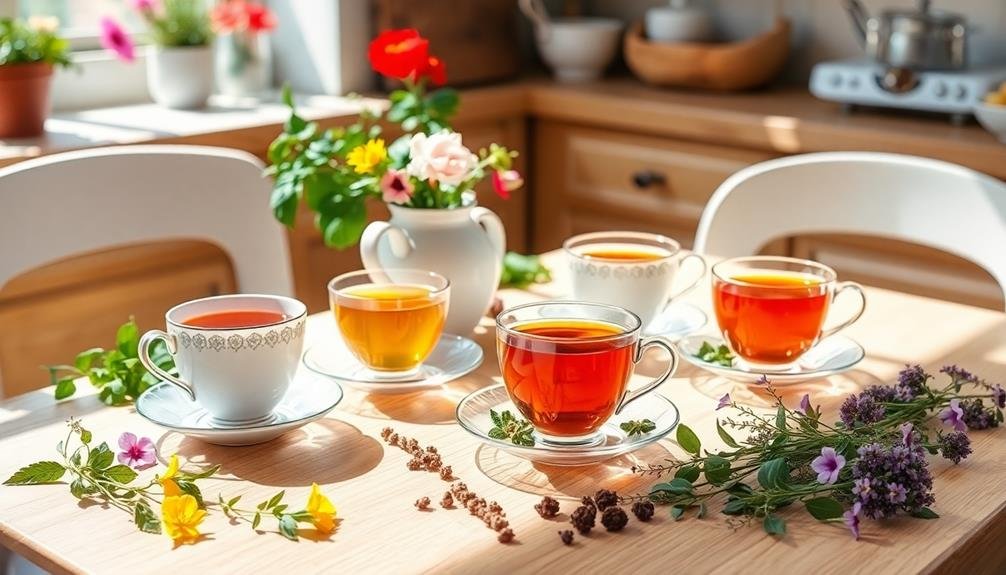
Sipping your carefully crafted herbal teas can be a truly enjoyable experience that engages all your senses. The aroma wafting from your cup invites you to dive deeper, while the vibrant colors in your mug tantalize your eyes.
As you take that first sip, you'll feel the warm liquid envelop your taste buds, offering a symphony of flavors.
To enhance your herbal tea experience, consider these tips:
- Create the right atmosphere: Find a cozy spot, dim the lights, and play soft music to set a relaxing mood.
- Experiment with pairings: Try pairing your tea with light snacks or desserts that complement its flavors, such as honey, lemon, or herbal-infused cookies.
- Mindful sipping: Take your time to savor each sip. Pay attention to how the flavors evolve on your palate and how they make you feel.
Frequently Asked Questions
Can I Use Store-Bought Dried Herbs for My Tea Blends?
Yes, you can definitely use store-bought dried herbs for your tea blends. Just make sure they're high-quality and fresh. Experiment with different combinations to find flavors that suit your taste and preferences. Enjoy your brewing!
How Long Do Dried Herbs Last Before Losing Flavor?
Dried herbs typically last about one to three years before losing flavor. To guarantee freshness, store them in a cool, dark place and check for aroma regularly. You'll enjoy your tea blends more this way!
Are There Any Herbal Teas to Avoid During Pregnancy?
During pregnancy, you should avoid herbal teas like sage, chamomile, and peppermint in large amounts. Always consult your healthcare provider for personalized advice, as some herbs may pose risks that you need to be aware of.
Can I Mix Dried Herbs With Fresh Flowers in Tea?
Yes, you can mix dried herbs with fresh flowers in tea! Just verify the herbs and flowers are safe for consumption. Experiment with flavors, but start with small amounts to find your perfect blend. Enjoy your creation!
What's the Best Way to Sweeten My Herbal Tea?
To sweeten your herbal tea, try adding honey, agave syrup, or maple syrup. You can also use stevia or sugar, adjusting to your taste. Experiment with different sweeteners to find your perfect flavor balance.
In Summary
Now that you know how to preserve your bloom bounty with perfect herbal tea blends, it's time to get creative! Experiment with different flowers and flavors to discover your favorite combinations. Remember, the joy of herbal tea lies not just in its taste, but also in the health benefits and the calming ritual of brewing. So gather your dried herbs, brew a cup, and savor the unique blend you've crafted. Enjoy every sip of your herbal journey!





Leave a Reply